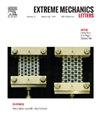Full range fragmentation simulation of nanoflake filler-matrix composite coatings on a polymer substrate
IF 4.3
3区 工程技术
Q2 MATERIALS SCIENCE, MULTIDISCIPLINARY
引用次数: 0
Abstract
This paper presents a comprehensive experimental and computational study to explore the damage evolution mechanisms of polymer matrix nanocomposite films consisting of rigid ceramic fillers coated on a polymer substrate. The weight ratio of montmorillonite (MMT) fillers in the polyvinyl alcohol (PVA) matrix ranges from 30 % to 70 %, and these are applied onto a polyethylene terephthalate (PET) substrate. Through experiments, apart from damage behaviors, the water vapor transmission rates are also measured to gain insight into moisture diffusion characteristics with varying weight ratios of fillers. The optimal weight ratio of nanocomposite films consisting of a PVA matrix with MMT fillers can vary depending on the purpose of damage resistance and moisture barrier characteristics. A peridynamic theory is employed to simulate various damage scenarios of bi-layer nanocomposite films. The solution strategy presented incorporates the use of the cut-boundary and finite element methods to reduce substrate thickness and make initial predictions of crack onset strains, respectively, under quasi-static loading conditions. Several damage scenarios are considered for thin and thick PVA films on the PET substrate, as well as weak to strong interfaces between the PET-PVA and PVA-MMT layers. Additionally, different distributions of MMT fillers are also considered by varying the distances between them and inserting inclusions. The peridynamic damage analyses encompass crack initiation, propagation, and final failure stages across a wide range of strains, including various damage modes such as matrix cracking, cracking at the filler-matrix, or matrix-substrate interfaces, leading to the cohesive film cracking and delamination.
聚合物基底上纳米片填料-基质复合涂层的全方位破碎模拟
本文通过全面的实验和计算研究,探讨了聚合物基质纳米复合薄膜的损伤演变机理,该薄膜由涂覆在聚合物基质上的刚性陶瓷填料组成。蒙脱石(MMT)填料在聚乙烯醇(PVA)基体中的重量比从 30% 到 70%不等,这些填料被涂覆在聚对苯二甲酸乙二醇酯(PET)基体上。通过实验,除了破坏行为外,还测量了水蒸气透过率,以深入了解不同重量比填料的湿气扩散特性。由 PVA 基体和 MMT 填料组成的纳米复合薄膜的最佳重量比可根据抗损坏性和防潮特性的目的而有所不同。本研究采用了周动力学理论来模拟双层纳米复合薄膜的各种损坏情况。所提出的求解策略结合使用了切割边界法和有限元法,以减少基材厚度,并在准静态加载条件下分别对裂纹起始应变进行初步预测。考虑了 PET 基底上的薄 PVA 薄膜和厚 PVA 薄膜以及 PET-PVA 层和 PVA-MMT 层之间由弱到强的界面的几种损坏情况。此外,通过改变 MMT 填料之间的距离和插入夹杂物,还考虑了 MMT 填料的不同分布。周动态损伤分析涵盖了各种应变下的裂纹起始、扩展和最终破坏阶段,包括各种损伤模式,如基体开裂、填料-基体或基体-基体界面开裂,从而导致内聚薄膜开裂和分层。
本文章由计算机程序翻译,如有差异,请以英文原文为准。
求助全文
约1分钟内获得全文
求助全文
来源期刊

Extreme Mechanics Letters
Engineering-Mechanics of Materials
CiteScore
9.20
自引率
4.30%
发文量
179
审稿时长
45 days
期刊介绍:
Extreme Mechanics Letters (EML) enables rapid communication of research that highlights the role of mechanics in multi-disciplinary areas across materials science, physics, chemistry, biology, medicine and engineering. Emphasis is on the impact, depth and originality of new concepts, methods and observations at the forefront of applied sciences.
 求助内容:
求助内容: 应助结果提醒方式:
应助结果提醒方式:


